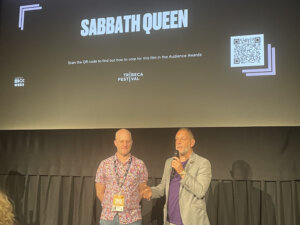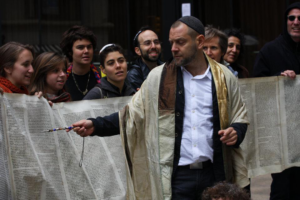Welcoming ‘Sabbath Queen,’ a new documentary about a rabbi who breaks all boundaries
There is a moment smack in the middle of the sprawling, subversive new documentary Sabbath Queen where the film’s subject, Rabbi Amichai Lau-Lavie, explodes with anger. It is 2014, during the last major Israel-Hamas war, and he is at a protest holding a sign that says “Stand with Israel/Mourn with Gaza” when a woman calls him a mamzer, Hebrew for “bastard.”
“Mamzer?” the Israeli-born Lau-Lavie responds with a native accent and equally authentic outrage. “My father’s a Holocaust survivor.”
“You don’t belong, carrying a sign like that,” the woman fairly spits.
“And I’m a bastard?” he counters in genuine disbelief.
“Yes, you are,” she insists. “That’s what you are. You should have died with them.”
The film, 21 years in the making, began as a biopic of the Rebbetzin Hadassah Gross, a drag character Lau-Lavie embodied for years who dispenses wisdom through a thick Eastern European accent and thicker false eyelashes. It morphed into a meditation on intermarriage along with Lau-Lavie, a descendant of a 1,000-year dynasty of Orthodox rabbis who surprised everybody by not just deciding to become a rabbi himself but doing so at the Conservative Jewish Theological Seminary.
And then, like so many things, it changed again after Oct. 7, to be about war and peace but mostly about what it was always fundamentally about — and what so many Jewish conversations these days are about: Boundaries.
“There must be boundaries in what we call the Jewish home,” Lau-Lavie’s brother, Rabbi Benny Lau, says at one point in the film.
“We’re pushing a lot of boundaries here, so there’s plenty to worry about in terms of backlash,” Lau-Lavie himself says a few beats later.
“We want to grow because of people like Amichai,” Rabbi Dan Nevins, then-dean of the Jewish Theological Seminary, says near the end. “And yet, we also believe that there’s something to be said for having boundaries to Jewish identity.”
To describe Lau-Lavie, 55, as a boundary-breaker would be something of an understatement. This is a man who grew up in Israel’s black-hatted precincts and while his uncle was serving as the Jewish state’s chief rabbi found a spiritual home in the countercultural/queer consciousness movement Radical Faeries. A performance artist who started Lab/Shul, the “everybody-friendly, God-optional, experiential community for sacred Jewish gatherings” in Manhattan. The bio-dad of three kids parented by two women, one of whom is now married to a transgender man.

A Conservative rabbi who ditched the movement a year after his ordination with a manifesto using Talmudic texts to justify marriages between Jews and non-Jews who meaningfully engage in Jewish life. A ceasefire promoter in a knitted kippah who has visited Israel seven times since Oct. 7, once for the wedding of a soldier-nephew who that very morning came off the battlefield in Gaza.
“I hold the pain of my Israeli family,” he says in the 105-minute film’s closing montage, which intertwines images of Israel hostage posters and of Gaza’s destroyed neighborhoods. “And our trauma and need for safety does not justify Israel starving and killing tens of thousands of Palestinians in Gaza and the continued occupation. This horror must stop.”
Originally, Lau-Lavie used the word but, not and. As in, “I hold the pain of my Israeli family, but our trauma … does not justify …” After screening the film with his brother Benny — who himself is quite a boundary-breaker, creating rabbinic leadership roles for women in Israel’s modern Orthodoxy — he decided it needed to be “and.”
“If there’s anything that people take from the film, I hope it’s the power of ‘and,’” Lau-Lavie said after a screening at the Tribeca Film Festival, where Sabbath Queen had its world premiere on Sunday and is showing again Friday afternoon. “What does it mean to stand with and with —with my people, and with all people. There is a messy middle. Let’s meet there.”
The film is directed by Sandi DuBowski, whose groundbreaking 2001 documentary Trembling Before G-d chronicled the journeys of queer Orthodox Jews. DuBowski asked Lau-Lavie to be part of Trembling, but as he recalls it, Lau-Lavie told him: “I don’t do collage; I want my own movie.”
Sabbath Queen turns out to be something of a collage. It is a movie about drag and queerness — and a movie a about the Holocaust. There are scenes of radically reinvented Jewish rituals — and scenes of Lau-Lavie, his brother and father wrapping tefillin in an centuries-old synagogue in Poland.
Radical Faery raves. The Rebbetzin Hadassah Gross submerging herself in the Dead Sea to unleash the shechinah, or female essence of the divine. Mixed marriages. But also: Lau-Lavie’s Orthodox bar mitzvah, the image of his rabbi-grandfather who was killed along with his Polish congregants in Buchenwald, hanging on his living room wall.
Hostage posters and devastation in Gaza. And, not “but.”
DuBowski told me he shot 1,800 hours of footage and collected 1,100 hours of archival video, plus “an enormous number of photos.” I asked how he knew when it was done.
“I guess we became very open to just making the movie what it needed to be, and not putting an end date on it,” he said. “Just being patient, and letting the story really unfold and listening deeply and carefully.”
Perhaps the most powerful element of the film is the way it echoes across time, space and reincarnations of Jewish identity. Lau-Lavie is part of an unbroken chain of 38 generations of rabbis, rooted in the time of Rashi. Early in the film, he tells the story of how his grandfather Rabbi Moshe Chaim Lau, chief rabbi of the Polish city of Piotkrow, went with its 40,000 Jews to Treblinka even though he had a visa and could have escaped.

“My grandfather led his congregation into the gas chamber and he read the Kaddish with them and he read the Shema with them,” Lau-Lavie says. “You know, that’s what a rabbi does. A rabbi doesn’t leave his congregation.”
An hour later, he uses the same words to explain why he decided to resign from the Conservative movement’s Rabbinical Assembly, over its prohibition on members officiating at intermarriages.
“I think I’m doing the right thing,” he says. “A hundred years from now, maybe we will look back and know if this was a choice that validates continuity or just responds to this moment and disrupts continuity too radically. I don’t know. We won’t know. But a rabbi doesn’t leave his congregation.”
The intermarriage debate is about navigating the boundaries of Jewish belonging: Lau-Lavie and other progressive Jews have chosen to embrace non-Jewish spouses as part of the community.
Now, it is the war in Gaza that is challenging boundaries with a new slew of litmus tests. Pro-Israel Jews demand, “Do you condemn Hamas?” and call members of anti-Zionist groups like Jewish Voice for Peace “kapos” or worse. Leftists meanwhile insist on describing Israel as engaged in genocide and banning all who support its right to exist from certain spaces.
Lau-Lavie has taken to wearing purple — a color he described as “regal” — to represent his “both/and” philosophy.
“Purple is the color that might save America,” he told me. “We feel there is a place where we meet each other in the middle, where our eyes meet each other.”
I asked if his message is that there should be no boundaries — or where he would set them.
“Part of where the boundaries matter is not the what, but the how, like the language people use,” he said. “The boundaries are when someone shouts at me ‘Kill the Jews’ or when someone shouts at me ‘Palestinians have no right to live’ and ‘faggot’ or ‘mamzer.’
“I get it. I’ve lost my temper and I do it often and I try not to,” he continued. “But that’s one boundary. Not so much what we say but how we say it.”
Sabbath Queen has its third Tribeca Film Festival screening today at 2:30 at Manhattan’s Village East by Angelika theater. It will also be shown Sunday at the DC/DOX festival, and at upcoming festivals in New Zealand and San Francisco.
The post Welcoming ‘Sabbath Queen,’ a new documentary about a rabbi who breaks all boundaries appeared first on The Forward.
from The Forward https://ift.tt/hpLeCb4
Comments
Post a Comment